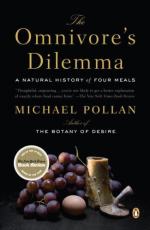
|
| Name: _________________________ | Period: ___________________ |
This test consists of 5 multiple choice questions, 5 short answer questions, and 10 short essay questions.
Multiple Choice Questions
1. Pollan tries to be vegetarian, but gives it up as he finds it less ________ and much more difficult.
(a) Exciting.
(b) Socially acceptable.
(c) Nutritious.
(d) Innovative.
2. What is the herbal tea that Pollan makes to help finish off the meal he has made?
(a) Lavender.
(b) Fig.
(c) Chamomile.
(d) Mint.
3. What would the company that raised Pollan's steer not allow him to do?
(a) Watch it be processed.
(b) Take any notes.
(c) Come to see the farm.
(d) Pay for his steer.
4. Pollan doesn't feel the same about the picture a few months later and wonders which emotion is more accurate - the happiness or the ________.
(a) Shame.
(b) Anger.
(c) Terror.
(d) Disgust.
5. Activists appear to look at the __________ animal, which is not applicable to the natural world.
(a) Species of an.
(b) Individual.
(c) Distinct.
(d) Relationship of an.
Short Answer Questions
1. The meal also brings ________ to the table, which is another way of saying thanks to the animals.
2. Supporting farms help animals to have safer lives than they might have in the ________, according to Pollan.
3. Assuming a higher intelligence in humans does not equate to a right to use others for our own _________.
4. Pollan equates the feeling of everything coming into focused while also being completely relaxed to being ________.
5. Pollan also makes two entrees, one of grilled and one of braised __________.
Short Essay Questions
1. What does Pollan begin to experience after a day of hunting for a wild boar?
2. What does Pollan suggest that our intelligence allows a person to do that an animal cannot?
3. Why is Bev having troubles getting his eggs into stores and into the market?
4. What does Ortega y Gasset have to say about the idea of hunting?
5. Why is there a national eating disorder, according to Pollan's findings?
6. What is Pollan surprised about when he begins to eat the meal that he has prepared?
7. What does Pollan believe that CAFO does not take into consideration when processing meat?
8. What do omnivores do when they are faced with a new food?
9. Why is Pollan disgusted by the picture of him with a pig that he hunted?
10. What does Salatin suggest stores should do with their food which might make consumers shop differently?
|
This section contains 564 words (approx. 2 pages at 300 words per page) |

|




